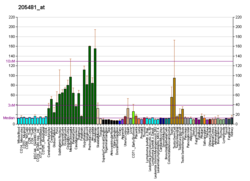Top Qs
Timeline
Chat
Perspective
Adenosine A1 receptor
Cell surface receptor found in humans From Wikipedia, the free encyclopedia
Remove ads
The adenosine A1 receptor (A1AR) [5] is one member of the adenosine receptor group of G protein-coupled receptors with adenosine as endogenous ligand.
Remove ads
Biochemistry
A1 receptors are implicated in sleep promotion by inhibiting wake-promoting cholinergic neurons in the basal forebrain.[6] A1 receptors are also present in smooth muscle throughout the vascular system.[7]
The adenosine A1 receptor has been found to be ubiquitous throughout the entire body.[citation needed]
Signaling
Activation of the adenosine A1 receptor by an agonist causes binding of Gi1/2/3 or Go protein. Binding of Gi1/2/3 causes an inhibition of adenylate cyclase and, therefore, a decrease in the cAMP concentration. An increase of the inositol triphosphate/diacylglycerol concentration is caused by an activation of phospholipase C, whereas the elevated levels of arachidonic acid are mediated by DAG lipase, which cleaves DAG to form arachidonic acid. Several types of potassium channels are activated but N-, P-, and Q-type calcium channels are inhibited.[8]
Remove ads
Effect
This receptor has an inhibitory function on most of the tissues in which it rests. In the brain, it slows metabolic activity by a combination of actions. At the neuron's synapse, it reduces synaptic vesicle release.[citation needed]
Ligands
Caffeine, as well as theophylline, has been found to antagonize both A1 and A2A receptors in the brain.[citation needed]
Agonists
- 2-Chloro-N(6)-cyclopentyladenosine (CCPA).[citation needed]
- N6-Cyclopentyladenosine[citation needed]
- N(6)-cyclohexyladenosine[citation needed]
- Tecadenoson ((2R,3S,4R)-2-(hydroxymethyl)-5-(6-
((R)-tetrahydrofuran-3-ylamino)-9H-purin-9-yl)-tetrashydrofuran3,4-diol) [9]
PAMs
- 2‑Amino-3-(4′-chlorobenzoyl)-4-substituted-5-arylethynyl thiophene # 4e[11]
Antagonists
- Non-selective
- Selective
- 8-Cyclopentyl-1,3-dimethylxanthine (CPX / 8-cyclopentyltheophylline)[citation needed]
- 8-Cyclopentyl-1,3-dipropylxanthine (DPCPX)[citation needed]
- 8-Phenyl-1,3-dipropylxanthine [citation needed]
- Bamifylline [citation needed]
- BG-9719[12]
- Tonapofylline (BG-9928)[13]
- FK-453 [citation needed]
- FK-838 [citation needed]
- Rolofylline (KW-3902)[14][15]
- N-0861 [citation needed]
- ISAM-CV202[16]
Remove ads
In the heart
Summarize
Perspective
In the heart, A1 receptors play roles in electrical pacing (chronotropy and dromotropy), fluid balance, local sympathetic regulation, and metabolism.[9]
When bound by adenosine, A1 receptors inhibit impulses generated in supraventricular tissue (SA node, AV node) and the Bundle of His/Purkinje system, leading to negative chronotropy (slowing of the heart rate).[9] Specifically, A1 receptor activation leads to inactivation of the inwardly rectifying K+ current and inhibition of the inward Ca2+ current (ICa) and the 'funny' hyperpolarization-activated current (If).[17] Adenosine agonism of A1ARs also inhibits release of norepinephrine from cardiac nerves.[18] Norepinephrine is a positive chronotrope, inotrope, and dromotrope, through its agonism of β adrenergic receptors on pacemaker cells and ventricular myocytes.[19][20]
Collectively, these mechanisms lead to an myocardial depressant effect by decreasing the conduction of electrical impulses and suppressing pacemaker cells function, resulting in a decrease in heart rate. This makes adenosine a useful medication for treating and diagnosing tachyarrhythmias, or excessively fast heart rates. This effect on the A1 receptor also explains why there is a brief moment of cardiac standstill when adenosine is administered as a rapid IV push during cardiac resuscitation.[citation needed] The rapid infusion causes a momentary myocardial stunning effect.
In normal physiological states, this serves as protective mechanisms. However, in altered cardiac function, such as hypoperfusion caused by hypotension, heart attack or cardiac arrest caused by nonperfusing bradycardias, adenosine has a negative effect on physiological functioning by preventing necessary compensatory increases in heart rate and blood pressure that attempt to maintain cerebral perfusion.[citation needed]
Metabolically, A1AR activation by endogenous adenosine across the body reduces plasma glucose, lactate, and insulin levels, however A2aR activation increased glucose and lactate levels to an extent greater than the A1AR effect on glucose and lactate.[21] Thus, intravascular administration of adenosine increases the amount of glucose and lactate available in the blood for cardiac myocytes. A1AR activation also partially inhibits glycolysis, slowing its rate to align with oxidative metabolism, which limits post-ischemic damage through reduced H+ generation.[22]
In the state of myocardial hypertrophy and remodeling, interstitial adenosine and the expression of the A1AR receptor are both increased. After transition to heart failure however, overexpression of A1AR is no longer present.[23] Excess A1AR expression can induce cardiomyopathy, cardiac dilatation, and cardiac hypertrophy.[24] Cardiac failure may involve increased A1AR expression and decreased adenosine in physical models of cardiac overload and in dysfunction induced by TNFα.[25] Heart failure often involves secretion of atrial natriuretic peptide to compensate for reduced renal perfusion and thus, secretion of electrolytes. A1AR activation also increases secretion of atrial natriuretic peptide from atrial myocytes.[26][27]
Remove ads
References
External links
Wikiwand - on
Seamless Wikipedia browsing. On steroids.
Remove ads






